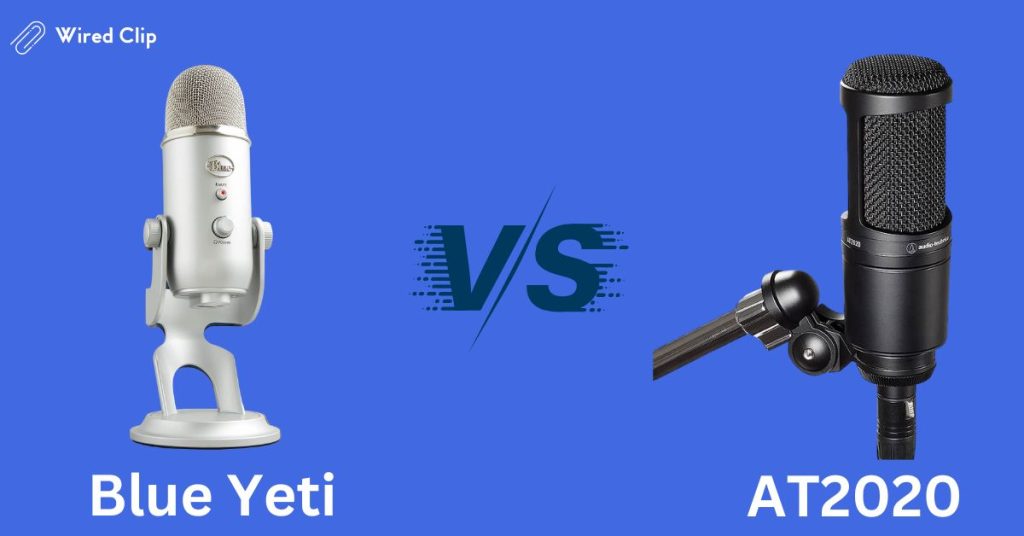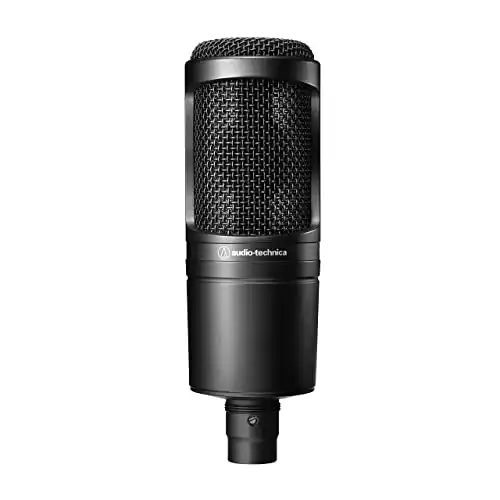Trying to choose the best microphone for you and your project—whether it be for recording music, sound effects, or speech—can be a difficult task.
You’re going to need something reliable, something with great sound quality, something that will last you, and something that won’t break the bank.
Most microphones will promise you all these things, but without being able to try them out in person, how can you know which is the right one for you?
Two options that prospective buyers often look at are the Blue Yeti and the Audio Technica AT2020.
Both microphones are great options, with users that swear by them, but when you’re taking a look at their specs it all seems overwhelming. How can you be sure you’re making the right choice?
Which one is better for the project you’re working on?
If you’re wondering about these questions, don’t panic! You’ve come to the right place!
In this article, we’re going to take you through everything you’ll need to know about these two microphones and conduct a thorough comparison so that you can decide.
We’ve also made sure to include a short FAQ to answer any questions you may have left over at the end.
Blue Yeti Overview
Blue is a company that has strived to make premium-quality microphones at affordable quality. One of their most popular models is the Blue Yeti.
An extremely popular choice for vloggers, YouTubers, and streamers, this USB condenser microphone is tried and tested (also see, ‘Best USB Podcasting Mics‘).
It’s widely regarded as one of the best USB microphones you can find and has a lot of great features that we’re going to cover in the sections below.
- Release: September 2019
- Weight: 1.27kg
- Dimensions: 11×12.2x.28.9 cm
- Original Price: $139.99
Main Pros
Sound Quality
The Blue Yeti mic doesn’t stack up so well against the most expensive USB mics on the market, but it’s very impressive when compared to some of its direct competitors.
Being a USB mic, you need a USB cable to connect the Blue Yeti to your computer. The Yeti also requires a bit of setup before you can start recording, but it’s fairly easy to get the hang of.
You might hear a small amount of pop every now and then, as well as some sensitivity problems, but it generally gives you a clear and crisp sound providing you have a quiet recording environment (also see, ‘Blue Yeti Pop Filter’).
Pickup Patterns
The Blue Yet is a versatile microphone offering several different pickup polar patterns, which allow for flexible recording. This can be especially important if you’re on the move and recording in different settings.
The Blue Yeti has four polar patterns: cardioid, omnidirectional, bidirectional, and stereo. The cardioid pattern is best for recording vocals, while the omnidirectional pattern will be great for capturing a range of sound from all directions.
The stereo pattern records the left and right channels separately, allowing you to create a stereo image of your sound source when mixing.
The bidirectional pattern is good for recording interviews or conversations between two people. This versatility makes the Yeti a great choice for podcasts and other applications where different polar patterns are needed.
The flexibility here is something that you won’t be able to get with other mics at the same price point.
User Display

Another great thing about the Blue Yeti is its on-mic levels display, which allows you to easily adjust sound levels.
You can monitor them as you’re recording without having to go into software panels on your PC or laptop.
This is a small feature, but something that makes the microphone easy to understand for beginners.
Aesthetic
This is probably the least important factor, but something you might want to consider if you’re going to be featuring your microphone in a YouTube video or live on Twitch.
If you want something slick and good-looking then this is a great choice. We’d personally recommend the blue color option, it’s a great shade and will likely fit with a lot of different desk/room setups.
Main Cons
Size
One thing to note here is that the Blue Yeti is a rather large microphone when compared to its capabilities. It’s likely to take up a lot of space on your desk and is rather bulky if you’re looking to travel with it.
This is the tradeoff you’ll have to make for its impressive quality, and for some, this is a fair price to pay.
Audio Technica AT2020 Overview
Next up, let’s take a look at the Audio Technica AT2020. It’s another simple mic at a low price point that offers fairly good sound quality.
It is a cardioid polar pattern condenser microphone, meaning it is more sensitive to sound coming from the front and rejects sound coming from the back. As such, it’s a great choice for recording vocals since you won’t need to worry about background noise as much.
Polar patterns are important to consider when selecting a microphone. The AT2020 has a fixed cardioid polar pattern, so you won’t be able to select different patterns like with some other mics.
This can be an issue if you need to record acoustic guitars or multiple instruments or sound sources in one space, but for recording vocals (which is what it was designed for), the AT2020 works great.
It has a wide frequency response range of 20-20KHz which makes it suitable for voice recordings as well as acoustic guitar and other instruments.
Finally, the AT2020 is easy to set up and use so you can get recording right away!
The AT2020 is probably a better choice for musicians, and it’s a lot more lightweight than the Blue Yeti mic. In the sections below we’re going to give you a short overview of its key features.
- Release: April 2004
- Weight: 345g
- Dimensions: 162X52mm
- Original Price: $99.00
Main Pros
Size/Weight
The first thing we want to highlight here is how lightweight this microphone is.
With a simplistic tube design and large grille, it’s a simple mic to set up and get started with, as well as to transport around with you no matter where you’re looking to record.
The AT2020 has an XLR output, which means it requires an audio interface to use with a computer.
To reference our previous comment about it being good for musicians, it’s a perfect little mic to carry around with you if you’re looking to do some home recordings with minimum setup and bother.
Durability

To expand on our size/weight pro, it’s also very a very durable mic. This is a microphone that has been created to mitigate the damage if you ever end up dropping it or anything else unfortunate that could happen during the recording process.
This can give you great piece of mind, especially considering you’re likely to spend just under $100 on this mic.
Sound Quality
Now this one can be seen as a pro or a con, depending on what you’re looking for. It’s not a bad microphone for its price point, but it does suffer a little with some recording errors and additional pop (even with a pop filter).
It also struggles a little with sensitivity, which means you’ll have to position the sound you’re recording in the right place to get the most balanced sound.
This is why we’re highlighting that this is a good mic for home recordings with music rather than crisp, clear sound. When put to the task of simplistic recordings, it does really well and exists as the perfect starter mic.
Main Cons
Self Noise
The worst thing about the AT2020’s sound quality is probably its self-noise. This means you’ll get additional white noise when recording that you can’t avoid, no matter how silent or well-set up your recording space is.
This can be fixed to an extent with audio editing software, but a good rule to keep in mind is the quality of your recording will only ever be as good as the quality of your microphone.
It’s small things like this that can cause the AT2020 to be unsuitable for high-quality recordings.
Which Is Better For You?
Which microphone is better for you will depend massively on what you’re looking to use it for. Let’s start off with the Blue Yeti. The Blue Yeti is a great choice if you’re looking to record high-quality voices.
This is especially useful if your project or projects involve speaking. This makes the Blue Yeti a great choice for YouTube channels, podcasts, vlogging, or general streaming purposes.
The AT2020 is probably better if you’re looking for something portable and durable that can record well enough in a variety of different settings.
It’s going to be the inferior choice for voice recordings, but if you’re good at editing audio software you’ll be able to create something that is passable.
We’d recommend the AT2020 for a musician who is looking for something to carry around with them and record music on the go.
Final Thoughts

So there you have it! That was a quick look at the Blue Yeti and the AT2020. The mic you decide to go with will have to depend a lot on the type of recordings you’re looking at doing.
Overall, both the Blue Yeti and AT2020 are great mics that will get the job done without breaking the bank. Generally, the Blue Yeti has a much more dynamic recording potential, but it’s much bulkier and less portable than the AT2020.
If you want to know a little more about some things to look out for when shopping online or in stores, check out our short FAQ below.
We hope that this guide has helped you to understand the main differences between these two microphones and that you’re on your way to making a decision.
Frequently Asked Questions
How Do You Know If A Microphone Has Good Sound Quality?
There are a lot of different factors that can make a microphone’s sound quality good or bad, but there are a few key things to consider before making a purchase.
Polar Response: The polar response is how sensitive your mic is in relation to the direction of the sound you’re recording. This is sometimes expressed as a curve around the grille of your microphone.
Sensitivity: The more sensitive your microphone, the more sound it will be able to pick up. Generally speaking, if your microphone is sensitive you will be able to get clearer recordings, but you will also get a lot more difficulties when it comes to pop and other sounds.
Maximum Sound Pressure: This one is something you’ll want to consider, depending on what you want to record. The higher the maximum sound pressure, the more sound the microphone will be able to take without sounds distorting.
More Blue Yeti Comparisons
- Blue Yeti vs Blue Yeti X
- Shure MV7 vs Blue Yeti
- AKG Lyra vs Blue Yeti
- Rode Podcaster vs Blue Yeti
- Elgato Wave 3 vs Blue Yeti
- Blue Yeti vs HyperX Quadcast
- Shure SM7B vs Blue Yeti
- Samson Q2U vs Blue Yeti
- Samson Q9U vs Blue Yeti
- Audio Technica ATR2100 vs Blue Yeti











